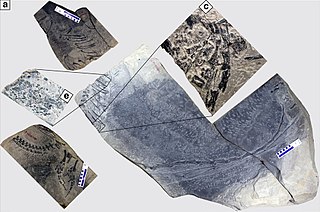
Dinocephalosaurus is a genus of long necked, aquatic protorosaur that inhabited the Triassic seas of China. The genus contains the type and only known species, D. orientalis, which was named by Li in 2003. Unlike other long-necked protorosaurs, Dinocephalosaurus convergently evolved a long neck not through elongation of individual neck vertebrae, but through the addition of neck vertebrae that each had a moderate length. As indicated by phylogenetic analyses, it belonged in a separate lineage that also included at least its closest relative Pectodens, which was named the Dinocephalosauridae in 2021. Like tanystropheids, however, Dinocephalosaurus probably used its long neck to hunt, utilizing the fang-like teeth of its jaws to ensnare prey; proposals that it employed suction feeding have not been universally accepted. It was probably a marine animal by necessity, as suggested by the poorly-ossified and paddle-like limbs which would have prevented it from going ashore.

Pteronisculus is an extinct genus of prehistoric ray-finned fish that lived during the Early Triassic and Middle Triassic epochs of the Triassic period worldwide.
Luganoia is an extinct genus of prehistoric bony fish that lived during the Anisian and Ladinian ages of the Middle Triassic epoch. Fossils were recovered from the Besano Formation of Monte San Giorgio and Besano area and from the Zhuganpo Member of Guizhou, South China. It was also reported from the Ladinian of Spain.
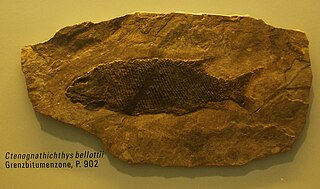
Ctenognathichthys is an extinct genus of prehistoric bony fish that lived during the Anisian and Ladinian ages of the Middle Triassic epoch in what is now southern/southeastern Switzerland and northern Italy.
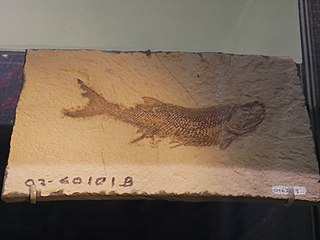
Cyranorhis is an extinct genus of prehistoric bony fish that lived during the Serpukhovian age of the Carboniferous period in what is now Montana, United States.
Platysiagum is an extinct genus of prehistoric bony fish belonging to the family Platysiagidae. Fossils are known from the Middle Triassic of China, Italy and Switzerland, and the Early Jurassic of England.
The Guanling Formation is a Middle Triassic geologic formation in southwestern China.
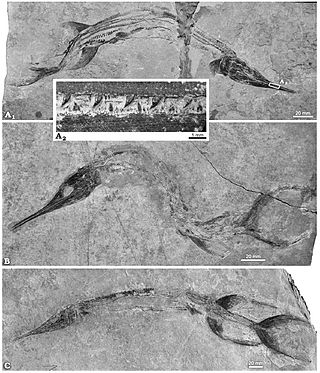
Sinosaurichthys is an extinct genus of saurichthyid ray-finned fish, which existed in southwestern China during the Middle Triassic. Fossils have been found in the Upper Member of the Guanling Formation of two localities: Yangjuan of Panxian County, Guizhou Province, and Dawazi of Luoping, Yunnan Province, China.

Sinosaurosphargis is an extinct genus of basal marine saurosphargid reptile known from the Middle Triassic Guanling Formation of Yunnan and Guizhou Provinces, southwestern China. It contains a single species, Sinosaurosphargis yunguiensis.

Perleidiformes are an extinct order of prehistoric ray-finned fish from the Triassic period Although numerous Triassic taxa have been referred to Perleidiformes, which ones should be included for it to form a monophyletic group is a matter of ongoing scientific debate.

Luoxiongichthys is an extinct genus of basal actinopterygian known from the lower Middle Triassic of Luoxiong Town, Luoping County of Yunnan Province, southwestern China.
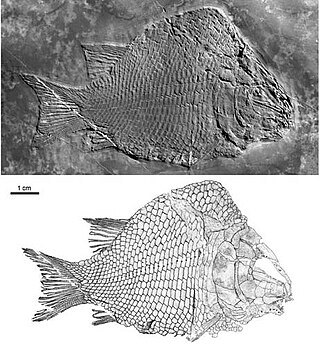
Kyphosichthys is an extinct genus of basal actinopterygian bony fish known from the lower Middle Triassic (Anisian) marine deposits in Luoping, eastern Yunnan Province, southwestern China. The species is the first known fossil record of highly deep-bodied ginglymodians.
Largocephalosaurus is an extinct genus of basal saurosphargid, a marine reptile known from the Middle Triassic Guanling Formation of Yunnan and Guizhou Provinces, southwestern China. It contains a type species, Largocephalosaurus polycarpon, and a second species L. qianensis.

Saurosphargidae is an extinct family of marine reptiles known from the Early Triassic and early Middle Triassic of Europe and China.

Pectodens is an extinct genus of archosauromorph reptile which lived during the Middle Triassic in China. The type and only species of the genus is P. zhenyuensis, named by Chun Li and colleagues in 2017. It was a member of the Archosauromorpha, specifically part of the unnatural grouping Protorosauria. However, an unusual combination of traits similar and dissimilar to other protorosaurs initially led to confusion over its evolutionary relationships. In 2021, it was placed in a newly-established group, Dinocephalosauridae, along with its closest relative Dinocephalosaurus.

Ginglymodi is a clade of ray-finned fish containing modern-day gars (Lepisosteidae) & their extinct relatives in the order Lepisosteiformes, the extinct orders Semionotiformes and Kyphosichthyiformes, and various other extinct taxa. Ginglymodi is one of the two major subgroups of the infraclass Holostei, the other one being Halecomorphi, which contains the bowfin and eyespot bowfin and their fossil relatives.

Teffichthys is an extinct genus of ray-finned fish from the Early Triassic epoch. Fossils have been found in Madagascar and China, and possibly also in Angola, Canada, Greenland, and Svalbard.

Colobodontidae is an extinct family of marine stem-neopterygian fish known from the Middle to Late Triassic of Asia and Europe. As currently defined, it contains three genera: Colobodus, Crenilepis and Feroxichthys. The colobodontids were medium-sized, somewhat deep-bodied fishes with a durophagous diet. Like many other stem-neopterygians, they have traditionally been placed in the order Perleidiformes, which is now thought to be paraphyletic.

Luopingosaurus is an extinct genus of pachypleurosaurid sauropterygian from the Middle Triassic Guanling Formation of Yunnan Province, China. The genus contains a single species, L. imparilis, known from a well-preserved, nearly complete skeleton.
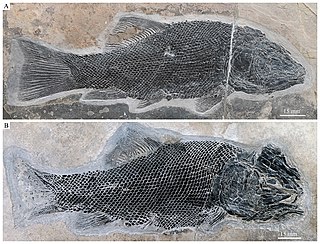
Robustichthys is an extinct genus of ray-finned fish from the Middle Triassic period, contains only one species R. luopingensis. It belonged to the clade Halecomorphi, which were once diverse during the Mesozoic Era, but which are today represented by only a single species, the bowfin. Halecomorphs are holosteans, a clade which first appeared in the fossil record during the Triassic.



















